
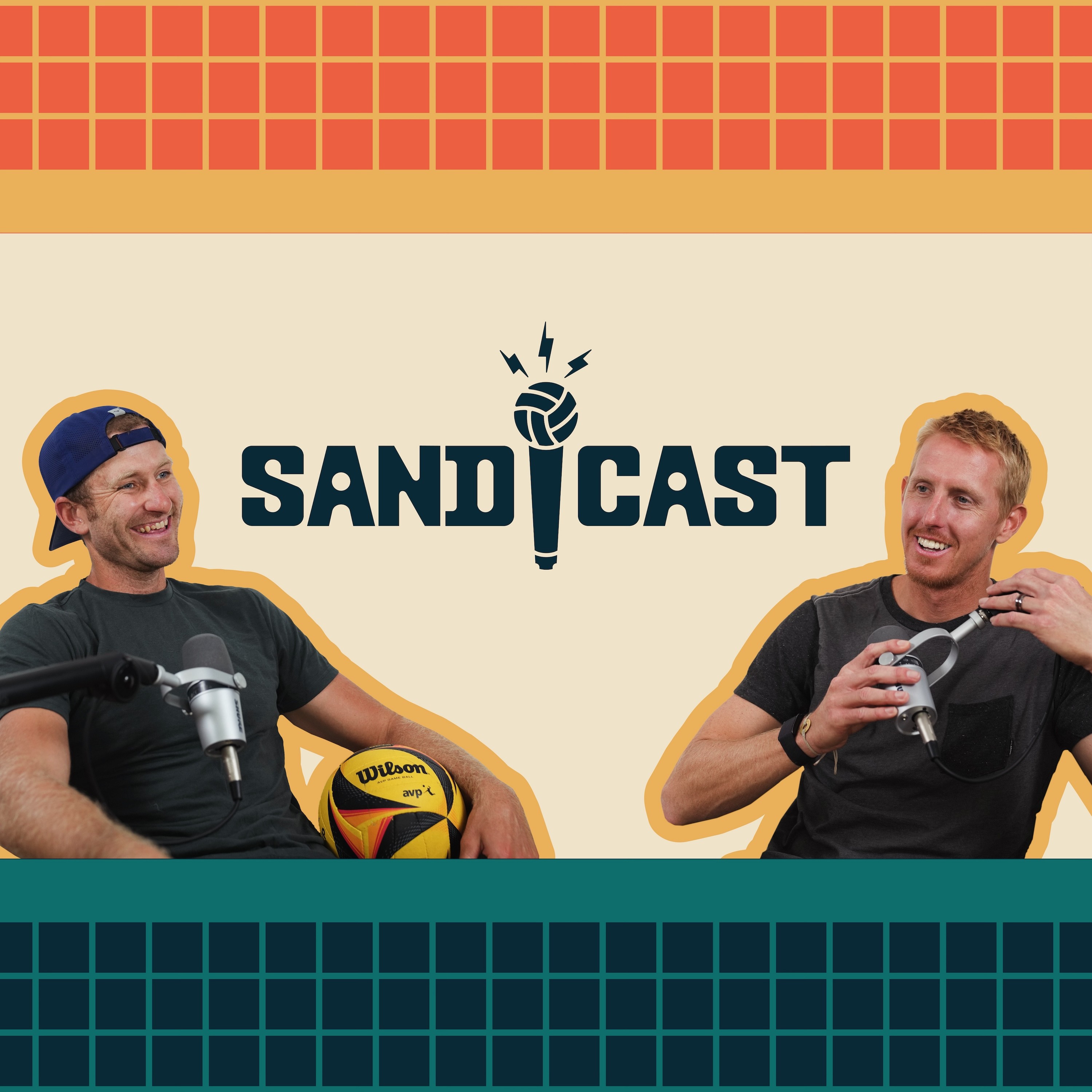
1.1M
Downloads
487
Episodes
SANDCAST is the first and leading beach volleyball podcast in the world. Hosts Tri Bourne and Travis Mewhirter take listeners into the world of the AVP, Volleyball World Beach Pro Tour and any other professional beach volleyball outlets, digging deep into the lives of the players both on and off the court as well as all of the top influencers in the game.
Episodes
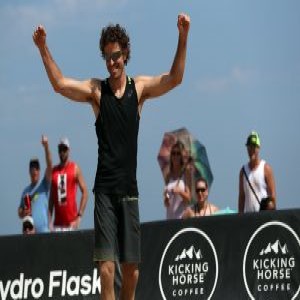
Wednesday Nov 21, 2018
John Mayer turns focus to full-time coaching
Wednesday Nov 21, 2018
Wednesday Nov 21, 2018
It’s fitting that John Mayer would spend much of his retirement podcast talking about everyone except John Mayer.
Much of it was spent discussing Trevor Crabb, despite Mayer even catching himself midway through and mentioning that he didn’t want it to be “a full Trevor Crabb podcast.” It didn’t stop him from singing Crabb’s praises further, though, nor did it stop him from elaborating on the positives of former partners Jeremy Casebeer, Ryan Doherty, Brad Keenan as well as his podcast partner, Billy Allen. Almost anyone who Mayer came into contact with over the course of a career that spanned from 2003-2018, he made sure to bring up.
It was a podcast as fitting as the manner in which he made his retirement known, which is to say, completely on accident.
“I didn’t want to make a deal of it,” he said on SANDCAST: Beach Volleyball with Tri Bourne and Travis Mewhirter. “I had known this year – it’s just been so hard to do LMU and play at a high level, and I felt like I was being average at both. And plus, my passion’s gone to coaching. I just love it, I get consumed by it. I thought this might be my last year [playing]. I just thought I’d see how I feel in the off-season, if I felt like I was missing something. I still loved all the coaching and I wasn’t missing the lifting and conditioning.
“I told my wife on our way to the AVP banquet, because she’s the one who would say something, just ‘Please don’t say anything. I don’t have a speech prepared, not that anyone would care’ but I knew she might say something to Mark [Schuermann, the AVP’s emcee]. She said ‘Oh, yeah, I won’t say anything,’ so the night was going through fine, ‘Alright, I’m off the hot seat, having a good time, just hanging out,’ and at the end of the night, Mark starts talking about me, and I’m like ‘What is he doing?’ And he says ‘Come up here!’ And I’m like ‘Why do I have to go up there?’ And he says ‘You gotta say something!’ My absolute nightmare.”
The reception, of course, was warm across the board. Quiet and humble, soft-spoken and endearingly self-deprecating, Mayer is retiring as one of the most respected players in the country, both for the way he played and the manner in which he carried himself.
Retiring, too, almost seems like a misnomer. He’s retiring as a player, yes, but Mayer actually might be on the beach more now than in the past decade. With the time he’d typically devote to the weight room, he’s now available to coach beach teams, the first of which to hire him is Billy Allen and Stafford Slick. He’s helping launch a beach division of Gold Medal Squared. He’s devoting more of himself to Loyola Marymount, the program he has helped improve from 6-17 to 15-14 to 22-14.
And even the unquestionable, objective improvement he has overseen at LMU, he had to shed the credit.
“I think I just scheduled more matches so we could get more wins,” he said, laughing.
Ah, yes, it’s never to his own credit. The four AVP wins, two FIVB gold medals, 2015 AVP, 2015 Best Defensive Player – all a credit to someone else who helped him along the way, be it a coach (“I owe Tom Black everything,” he said), a partner, his wife, anyone.
That’s Mayer. He even mentioned that perhaps he would have had a more successful career in spots had he chosen to focus on improving himself a little more as opposed to always, always, always attempting to bring the best out of his partner. But that just wouldn’t have been Mayer.
He’s a coach, after all. Through and through.
Now he’s set aside to become the best he can be at that, a role in which his own improvement will mean the inevitable improvement and development of those around him.
A role befitting the man who has always put others first.

Wednesday Nov 07, 2018
Wilco Nijland, creator the King of the Court series
Wednesday Nov 07, 2018
Wednesday Nov 07, 2018
You’d have thought he was busy enough, Wilco Nijland. His plate of responsibilities includes only, oh, a 10-stop beach volleyball tour in the Netherlands, his role as the Controlling Operations Officer at Sportworx, and subbing in as the coach for the Dutch team of Sophie van Gestel and Marloes Wesselink.
Why not add an entire new concept, a four-stop, international beach volleyball tour, on top of all that?
In a year that was replete with new developments – a massive event to kick off the AVP season, a domestic invitational in Hawai’i, record FIVB events, the establishment of p1440 – Nijland’s brainchild, King of the Court, was the smash hit of 2018.
“It was 15-20 tournaments in a row,” Nijland said on SANDCAST: Beach Volleyball with Tri Bourne and Travis Mewhirter. “It was a lot. And, of course, it was the first time with the King of the Court so there was a lot of pressure. And the world was watching us so at times it was very heavy, but most of the time it was very good.”
All of the time, it seemed, it was very good. It was good for viewers, who packed stadiums in the Netherlands, Belgium, Hawai’i, and Huntington Beach for all four events. It was good for players, who were treated like, well kings, with hotels for a week, events every night – Dodgers games, dinners, parties, surf lessons, the works. It was good for the game, which received a jolt of fresh energy, a new format, new partnerships – the Netherlands’ Alex Brouwer and Russia’s Oleg Stoyanovskiy, for example, or Aleksandrs Samoilovs and Martins Plavins – and a pace of play that was at once exhilarating and fascinating.
“It’s so extremely fast. If you take a look in the stadium and you’re sitting there for five minutes, you already saw three amazing rallies going on. It’s completely different from normal beach volleyball, which is already fun. It’s a next level thing, I guess.”
Five teams play on a single court, in a hyper-speed display of offensive prowess and the occasional bicycle kick, the method used by Austria’s Alexander Horst to score a point in Utrect, the first event of the series.
“It’s engaging the entire time,” Bourne said. “The fans are getting to watch three plays in the time it would normally take one, but you’re also thinking strategically: ‘What should this team be doing? What are they trying to do?’ You’re constantly looking at the score so the fans are engaged the entire time.”
Bourne competed with Trevor Crabb in the Hawai’i and Huntington Beach King of the Court events, eliminated early in Hawai’i due to some alliances formed against them in order to push another team through to the next round.
By the next event, such tactics were banned, as the rules are still in constant flux, able to change on the fly.
“Each tournament did something a little better,” Nijland said.
And there will continue to be more tournaments. Four more, which will be cooperatively scheduled with the FIVB, is the plan for 2019, with designs on adding events all the way up to 10.
“Of course, there were things going wrong but it went very smooth and we succeeded in adding a different kind of beach volleyball format in the beach volleyball world,” Nijland said. “It was very successful because the players like it a lot, the fans like it a lot, the FIVB thought it was fantastic. We have some good partners. We can be very proud of our team and we can be excited about the possibilities we have.”
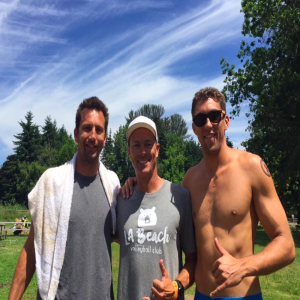
Wednesday Oct 24, 2018
Jeff Alzina: Architect of beach volleyball powers
Wednesday Oct 24, 2018
Wednesday Oct 24, 2018
In 1997, there were six countries with beach volleyball coaches for their national teams. Perhaps one of the most unqualified to do so was one of them.
Jeff Alzina had never coached on the beach prior to ’97, nor had he ever really played at much of a high level, having made just one AVP main draw, in Chicago of 1992. But he still trained with the top guys, setting up drills and competitive practices, making it so that his “biggest experience [on the beach] wasn’t necessarily competing at a high level, but training at a high level,” he said on SANDCAST: Beach Volleyball with Tri Bourne and Travis Mewhirter.
Being the practice guy everyone turned to paid off far more than being one of the top guys there to practice.
In September of 1997, the FIVB held a stop in Los Angeles, at the UCLA tennis center. Not long prior, Athens had been awarded the bid to the 2004 Summer Olympics, meaning Greece would have a bid for a beach volleyball team. Only, they didn’t have a team to send. So a few Greek representatives went to the U.S., then the unquestioned beach volleyball powerhouse of the world, to recruit someone who could launch their beach program. It would be someone young, preferably without a family, seeing as they’d have to relocate to Greece. Someone crazy enough to take on a beach volleyball program without a single beach volleyball player.
Someone like Jeff Alzina.
“They liked the way I worked with young people and thought I’d do a good job,” Alzina said. “So I was the national team’s director and head coach for men’s, women’s and junior volleyball.”
He got an apartment, was assigned an assistant, and then began scouring the country for beach volleyball players, with the goal to recruit a team who might become good enough to be competitive by the time the 2004 Olympics rolled around.
Alzina had a more expedited mission in mind. He found two indoor players by the names of Vasso Karadassiou and Efi Sfyri. They had played a few beach events, enough to be ranked 63 in the world.
Within a year, they were ranked No. 12, qualifying for the Sydney Olympics.
“It was surprising to a ton of people but I saw the talent in them right off the bat,” Alzina said. “To this day, I think the right-sider, [Karadassiou], was one of the best right-side defenders to ever play the game. They won a European Tour stop they had never won – they had never even medaled. So these girls just became national heroes and the federation went bananas too and went ‘Oh my God, let’s keep funding this thing. This is great.’ So the national tour grew, the juniors tour grew, those girls went on to be legends.”
And the legend of Alzina began. In Sydney, Alzina ran into Barbra Fontana, one of the best to ever play the game for the U.S. She had seen the work Alzina had done with Greece and offered to hire him to coach her and Elaine Youngs.
“After that hire, Elaine was good friends with Kevin Wong, Kevin said Elaine had only told him good things and…” the rest, you could say – and Alzina later would – is history.
He was hooked. And because he still hadn’t been coaching for long, his learning curve remained steep. He watched 25 hours of film a week, cutting it up on VHS tapes he still has at home. He began statting matches, reading everything he could get his hands on.
“It was like getting your 10,000 hours of coaching in one year,” he said. “It’s just a little bit of dumb luck, right place, right time, with some motivation.”
Since leaving the Greek program, Alzina has coached nearly three dozen Olympians and several hundred professionals in 83 open finals and counting. He has coached the USAV’s Elite Developmental Program and is currently overseeing its youth teams, which recently returned from a successful trip in Argentina, with two top-fives from the boys and girls teams.
This year, he helped with Trevor Crabb, who not coincidentally enjoyed the most successful year of his career internationally, with two gold medals and nearly a bronze in a four-star Olympic qualifier in Las Vegas.
In January, he got the call from Stein Metzger, whom Alzina coached in the 2004 Olympics, asking if he’d like to be his volunteer assistant. Alzina left a post at Long Beach State, where he had helped turn a program around from 13-14 to 26-10 in two years, and took the volunteer spot with the Bruins.
Metzger told the Daily Bruin that with Alzina, UCLA might be able to become a top-five team in the country.
In May, they won their first National Championship.
“I kinda thought Pepperdine was going to win it all and I thought USC had the talent to be in the finals again,” Alzina said. So it wasn’t going to be easy. He knew that. And when they lost in Gulf Shores to Florida State in their second match, he didn’t turn to the film, as he is wont to do, or to more reps, or to the weight room. No, one of the best coaching moves Alzina made as a Bruin was take the girls mini golfing.
“After that game, one of our freshmen said ‘I got something to say,’” he recalled. “And she said ‘Guys, we were supposed to lose this game. This year is not supposed to be a runaway for us. We’ve got to have a wakeup call and we’ve got to grind and that was the loss we needed. And it just sent this chill vibe to everyone where we’re not panicking, not going back to video to find out what was wrong with them. They just had to shed something off their back and look forward and be positive, and they did.”
So underestimate Alzina if you will. But from Greece to Fontana to the USAV youth to Crabb and now UCLA, Alzina is going to find a way to get his team – guys or girls, old or young, foreign or domestic – to win.
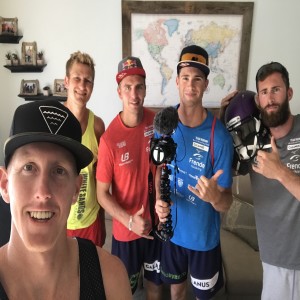
Wednesday Oct 17, 2018
The view from the Top of the World, with Norway's Anders Mol and Christian Sorum
Wednesday Oct 17, 2018
Wednesday Oct 17, 2018
John Mayer stood outside the player’s tent, not looking particularly disappointed despite being knocked out of the Huntington Beach Open less than an hour prior. He and Trevor Crabb had played their best match yet, he said.
Norway’s then-relatively unknown youngsters, Anders Mol and Christian Sorum, had simply played better.
“The blocker,” Mayer said, “reminds me of Phil [Dalhausser].”
A 20-year-old kid? Compared to Phil Dalhausser?
Had it been almost anyone else making that statement, an eye roll, a sigh, would have been acceptable. But Mayer isn’t one to simply dole out hyperbolic comments or undeserved praise. By year’s end, his comparison didn’t seem absurd, rather prescient.
Eight months later, Mol and Sorum are the undisputed best team in the world, and indeed, Mol was named the FIVB Blocker of the Year, with Sorum claiming Defender of the Year. As a team, they won Gstaad, and Vienna, and Hamburg, and then made yet another final in San Jose.
“If you would have told me at the beginning of the year that anyone would win three tournaments in a row,” Sorum said on SANDCAST: Beach Volleyball with Tri Bourne and Travis Mewhirter, “I would have said absolutely not.”
Perhaps only Mayer could have foreseen it. There’s no real reason anyone could have forecasted the breakthrough, not to these heights, at least. Prior to the Gstaad Major in mid-July, a Norwegian beach volleyball team hadn’t won a medal since 1997. The same year Mol was born.
It was uncanny, their poise in such a moment.
“We didn’t think about that at all,” Mol said. “You can’t think about that at all or you’ll lose. You have to stay in your own bubble. We don’t think about the crowd. We don’t think about what if we win and what can happen if we win. We just think about our game and the next ball and what we’re going to do and make a plan for every ball.
“When you see the videos we are really calm and really focused and not that many emotions from us.”
“We also,” Sorum added, “had a little bit of luck.”
They’re endearing, these Norwegians. Impossibly humble for such accomplished athletes, ones who rose from the qualifiers to the top of the world in half a year’s time. It’s a humility begat from both being products of a small town – Mol’s village has 500 “inhabitants,” as he described it – and taking the time to see the world in all of its massive beauty.
They’re volleyball players, yes, but they’ve taken on much more than that. They don’t simply bounce from hotel to hotel, AirBNB to AirBNB. There’s more to life than volleyball for them.
“I was sad for like two minutes in Hawai’i,” Sorum said, “and then I was like ‘Yes! We get to go see Hawai’i!’”
“I was stoked!” Mol’s brother, Hendrik, a University of Hawai’i alum, added.
They’ve explored, drinking in not just the beach volleyball life but the lifestyle that comes with it. In the gap between Warsaw and Espinho, Portugal, they saw a good deal of Poland. After getting knocked out in Russia, they saw Jay Z and Beyonce. Between San Jose and Las Vegas, they’ve become honorary South Bay residents after checking Yosemite off the bucket list.
It’s how they stay fresh, enthused, thrilled about this warp-speed lives their living.
“I think that’s really important just to get our minds off of volleyball for a little,” Mol said. “There is so much volleyball and also, in our family, we talk volleyball all the time. It’s really good just to get some days off when we’re not playing. I think that’s really important to keep our minds fresh and not always think about volleyball.”
While they give their minds a rest from volleyball, nearly everyone in volleyball is thinking about them.
“This off-season,” Jake Gibb said, “there’s going to be a lot of Norwegian film going around.”
You don’t have to look hard for it. They upload every match, along with highly entertaining vlogs of their travels, onto their YouTube channel, Beach Volley Vikings, for all the world to see. And that’s exactly the point: They want to grow the game. If they can put out information that will help others learn, that’s exactly what they’ll do.
“Just watch some video of these guys,” Hendrik said. “It’s great learning from these guys. They’re great athletes, they have some of the best technique in the game. Check them out for sure.”
Lord knows the rest of the world is.
As for the Norwegians?
They’re checking out the rest of the world.
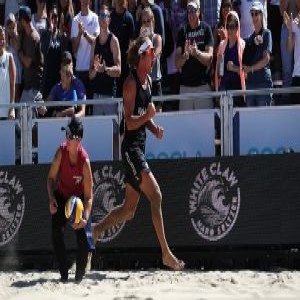
Wednesday Oct 03, 2018
The World Tour-cast with Norway, Canada, Latvia, United States
Wednesday Oct 03, 2018
Wednesday Oct 03, 2018
Martins Plavins requested the mic from Aleksandrs Samoilovs. Had to set some matters straight.
“I know,” Plavins said on Saturday night at p1440 San Jose, “that Edgars misses me.”
He was joking – maybe, possibly, perhaps – but Sunday’s result, when the Latvians upended the world’s best in Norway’s Christian Sorum and Anders Mol in the finals, proved that there’s likely a bit of truth to the notion that Edgars Tocs, Plavins’ typical partner, may have been missing his defender.
Plavins and Tocs, Latvia’s No. 2 team behind Samoilovs and the injured Janis Smedins, were one of the world’s most delightful surprises in the 2018 FIVB season. Entering the year, Tocs, a 29-year-old from Madona, had never eclipsed the five-figure threshold in prize money, with just three main draws to his name in all of 2017.
Yet there they were, on podium after podium to begin the year – gold at The Hague in January, silver in Kish Island a month later. By the end of the year they had played in 13 events, nearly as many main draws as Tocs had played in his entire career.
By season’s end, they were ranked fifth in the world, three spots behind Samoilovs and Smedins, and a country that is roughly the size of Nebraska in terms of population was suddenly home to two of the world’s beach volleyball powers.
Not that Latvia is an upstart. Not by any means. Ten years ago, Samoilovs and Plavins authored arguably the greatest upset in Olympic beach volleyball history when they stunned Phil Dalhausser and Todd Rogers in the first round of pool play. In 2012, Plavins did it again, this time with Smedins, upsetting Jake Gibb and Sean Rosenthal – then the No. 1 team in the world – in the quarterfinals of the 2012 Olympics in London.
“We used to play good together,” Samoilovs said. “[Martins] agreed to come to San Jose so I’m very happy he had a chance to join me.”
In two years, for the second time in three Olympics, they might very well join each other as teammates on separate teams. While Plavins was winning a bronze medal with Smedins in 2012, Samoilovs took a ninth with Ruslans Sorokins.
“Martins is one of the best defenders in the world,” Samoilovs said, which explained why, in San Jose, Samoilovs, typically a split-blocker, stayed at the net. “It doesn’t make sense to go block.”
Indeed it seemed they found the right defensive system, as they lost just one set the entire weekend in San Jose, to Austrian Olympian Alexander Huber and Leo Williams in the first round. After that, it was dominant win after dominant win, over Piotr Marciniak and Canadian Olympian Chaim Schalk, Spaniards Adrian Gavira and Pablo Herrera, Americans Miles Evans and Billy Kolinske and the world’s best in Noway’s Mol and Sorum.
More important for either than the winning, though, is the fact they have a chance to win anything at all. Samoilovs remembers what it was like post-2016, when the world tour had just eight events big enough for the best to play, when beach volleyball was somewhat of a wasteland.
With the advent of the King of the Court series and p1440, as well as the extension of the FIVB season, the sport has become nearly year-round.
“This is really great,” Samoilovs said. “I remember after the Rio Olympics, in 2017, it was a disaster. It was only eight World Tour events, so you spend three months preparation just to play eight weeks, two months, so for us players we’re relieved because of these tournaments. Our families live because of these tournaments. It’s important to have more opportunities and more tournaments to earn money and to have a better life.”
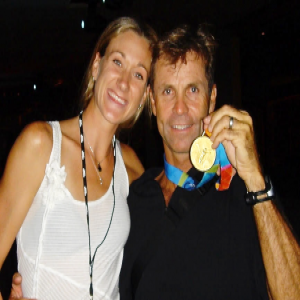
Wednesday Sep 26, 2018
Dane Selznick previews p1440 San Jose
Wednesday Sep 26, 2018
Wednesday Sep 26, 2018
Dane Selznick has seen it all.
Seen every last one of beach volleyball’s many evolutions. He was there when players competed for little more than pride and maybe – maybe – a free dinner. He was there when two men named David Wilk and Craig Masuoka formed a promotional company named Event Concepts and began hauling in the Millers and Cuervos of the world and throwing legitimate prize money into tournaments. He was there when the AVP Tour was founded, in 1984, and when it collapsed, and when it formed again, and when it collapsed once more, to be revived in its current iteration under Donald Sun.
He’s seen both the golden era, financially, when 10 players once banked more than $100,000 in prize money alone, and he’s seen the most dominant era, when Kerri Walsh-Jennings and Misty May-Treanor once rattled off 112 straight wins and three consecutive gold medals from 2004-2012.
And now he is witness once more to the latest permutation in professional beach volleyball, the upstart event series, p1440, founded by Walsh-Jennings and her husband, Casey, and former college teammate Dave Mays.
In March, Selznick, who had been a tournament director for the California Beach Volleyball Association (CBVA), founding the Gene Selznick Invitational, an eponymous nod to his father, was hired as p1440’s Director of Competition and Sport.
“About a year ago, Kerri approached me and said ‘Dane I have a project I’d love for you to be a part of,’” Selznick said on SANDCAST: Beach Volleyball with Tri Bourne and Travis Mewhirter. “She gave me a little bit of background, I brought it to the head staff at CBVA, got their opinion to see if it would be a good fit, and here we are. Everything’s moved along pretty quickly.”
Blindingly fast may be a more apt description. P1440 has announced dates for four events in its inaugural season, one of which will be an Olympic qualifier in Las Vegas, while the other three are partnered with the FIVB as international exhibitions. They’ve announced a lengthy list of sponsors that includes ROKA (eyewear), Alsa Energy (water), RX (protein bars), Brand X (strength and conditioning programs), AcuSpike (volleyball training), NormaTec (recovery), among a host of others. They’ve formed a developmental training program, replete with an armada of the finest coaches in the world, and a partnership with the CBVA, the pipeline from which many of the top players in the country cut their teeth, and where p1440 is now hosting what’s known as “satellite qualifiers,” allowing players to compete locally, weeks prior to the event itself, for a spot in the main draw.
“They looked at our [CBVA] schedule extensively, and they were trying to select those certain events that they felt fit the mold to be a qualifying point-getter for the players,” Selznick said. “There are specific tournaments that we have that award you p1440 points. The qualifying satellites are enticing for the players because it gives them something more than playing in a tournament. Now they’re playing for a main draw spot in tournaments that offer high level competition, a lot more prize money – you’re guaranteed more money just getting into the tournament. I think being an alternative tour to what we’ve got going on, as long as it’s not conflicting, I see no problem with it, because it really gives players a lot more opportunities to make money.”
More opportunities has been the theme of the past few months. In 2018, the AVP put on eight open events, one of which was partnered with the FIVB in Huntington Beach, before adding invitationals in Hawai’i and Huntington Beach. The upstart King of the Court series hosted another handful, to go along with upwards of 40 FIVBs of varying levels.
And now there’s p1440, adding events at the end of September (San Jose), mid-October (Las Vegas), end of November and early December (San Diego) and mid-December (Huntington Beach), with events on the horizon in Texas, Florida and Los Angeles.
“It seems like a pretty exciting time right now for the sport in general,” Tri Bourne said. “It’s cool, I think the sport is gaining a lot of momentum right now. There’s a lot of people like yourself and p1440 and AVP and King of the Court and FIVB and CBVA that are all kind of creating opportunities in their own way. I think it’s great. It seems like the sport is gaining some momentum.”
That next opportunity begins Thursday, with the San Jose on-site qualifier, and extends through the weekend, in a domestic event that features the top two teams in the world of each gender – Norwegians Anders Mol and Christian Sorum and Brazilians Carolina Salgado and Maria Antonelli – as well as a host of the best talent in the United States – Sean Rosenthal and Chase Budinger, Jeremy Casebeer and Reid Priddy, Billy Allen and Theo Brunner, Chaim Schalk and Piotr Marciniak, Walsh-Jennings, Nicole Branagh and Lauren Fendrick, Kelley Larsen and Emily Stockman, Caitlin Ledoux and Geena Urango.
“It’s just great to have more opportunity,” Selznick said. “Bottom line. Every entity should take care of its athletes. It’s like the Olympic Games, the athletes are No. 1.”
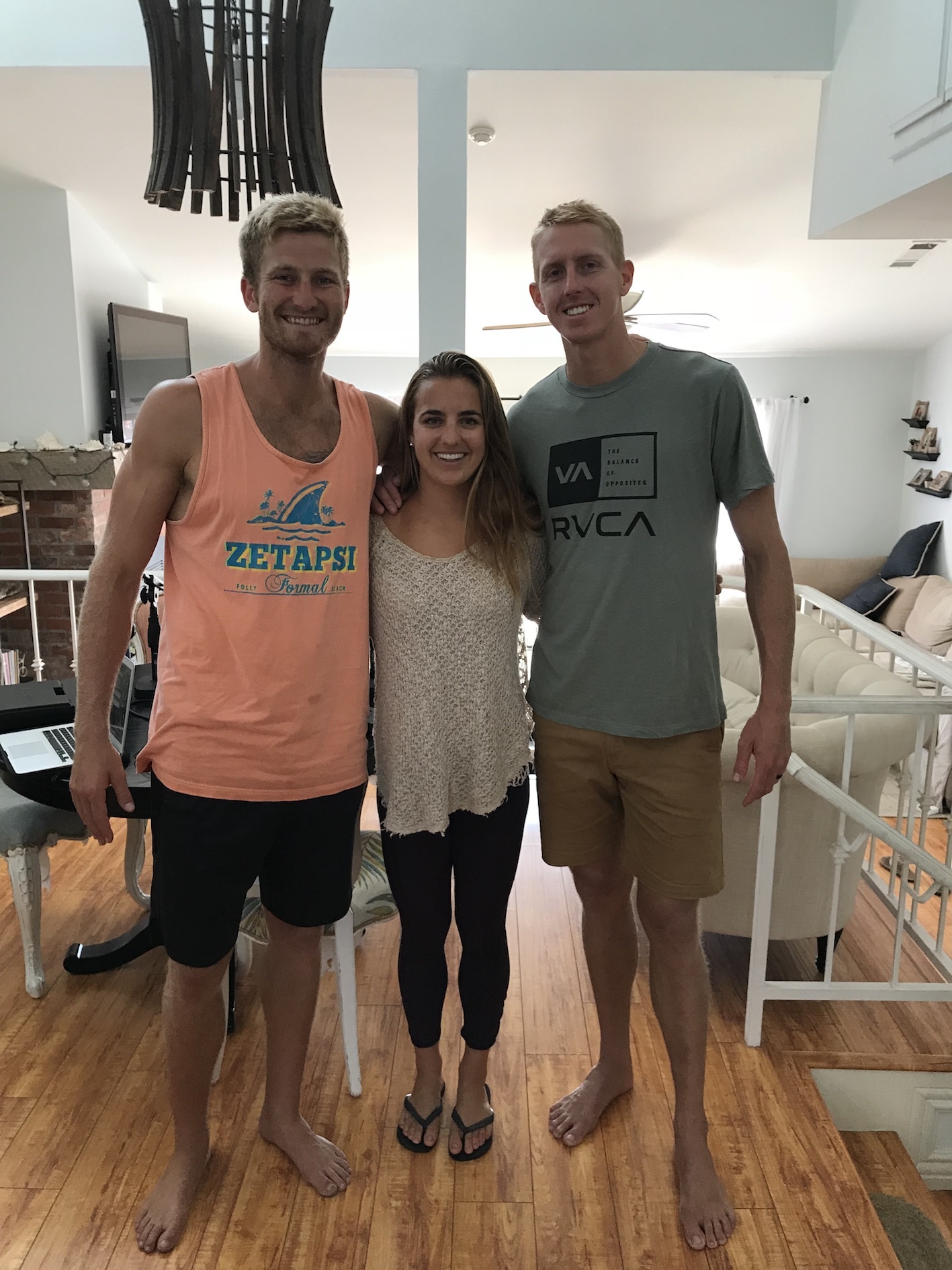
Wednesday Sep 05, 2018
Katie Spieler: 'Go out on the court and be you'
Wednesday Sep 05, 2018
Wednesday Sep 05, 2018
The beginning of the best year of Katie Spieler’s burgeoning career began at once brutally and spectacularly.
The brutal, as it tends to go in sports, preceded the spectacular, setback was succeeded by breakthrough.
“One of my worst matches was my first game in Austin,” Spieler said on SANDCAST: Beach Volleyball with Tri Bourne and Travis Mewhirter. “I was super bummed because I felt mentally not on, physically not on. I never call anyone on gamedays, but I called my sister and I was just like ‘I need your advice.’ Her advice was to just ‘Go out and be you. You don’t have to go out and try to be super confident and super aggressive. Just literally be yourself on the court and that’s when you’re going to play your best.’”
That initial 13-21, 22-20, 11-15 loss to Jace Pardon and Brittany Tiegs in the rearview, Spieler and partner Karissa Cook won their next four matches. Just like that, Spieler had gone from minor identity crisis to her first career AVP semifinal, blowing well past her previous career-best of seventh, at Chicago of 2016, all the way to the semifinals, her first Sunday.
“It felt way different,” Spieler said of the semifinal. “The vibes on a Sunday are totally different from even late on a Saturday. There’s so many fewer teams there and there’s a big crowd, and Austin was super weird because there was a rain delay. I think we’ve learned a lot since then just to take it as another match, but I think it was ‘Oh my gosh! We’re in the semis!’ Playing your game is just how you should approach every match.”
And it seems their own game works just fine. In five of the next six tournaments, they’d match or improve upon that previous career-high, finishing seventh or better in the final five events of the year.
“It was great learning with Karissa and getting better,” Spieler said. “Each tournament, unless you win, you end on a loss, so there’s always that, and there’s so much I want to work on and get better, but yeah, it was a great season.”
It was a season in which Spieler more than doubled her career prize money from the previous four seasons combined. A season in which, for the first time in her career, she didn’t have to play in a single qualifier. A season in which, once again, her and Cook tossed out many of beach volleyball’s norms and won and grinded in their own decidedly unique style.
“I don’t think it was one certain thing, but [Karissa] was coaching at Stanford all of last year so our practice was just playing in tournaments,” Spieler said. “That continued thoughout this season but for me this off-season I just worked on myself, and moving down [to Hermosa Beach] was huge. And [Karissa] just worked on herself this off-season and when we got together we were that much better because we had both worked on what we needed to and we got better as the year went on. It wasn’t one certain thing, we just both have a growth mindset and are working to get better individually.”
With the AVP regular season over, Spieler is left with perhaps two tournaments remaining on the 2018 calendar: a Norceca qualifier – and potentially the three events for which it would qualify them – and, potentially, an AVP Hawaii wild card.
Of the women’s teams vying for the wild card spot, it shouldn’t come as a surprise if the AVP taps Spieler and Cook, both of whom played for Hawaii, both of whom have a significant following on the islands.
Wild card or not, Spieler is simply going to continue doing what she does best: find a way to keep on winning.
“I don’t really set goals that I need to reach this goal by this date,” she said. “I don’t think I’ve ever been like that. It’s more like, ‘Ok, put my head down, grind it out, have fun, play,’ and then when I surface, it’s like ‘Oh, nice!’ If I did these things, great. My goal is just to keep playing at the highest level I can play for as long as I can play, because I just love playing volleyball.”
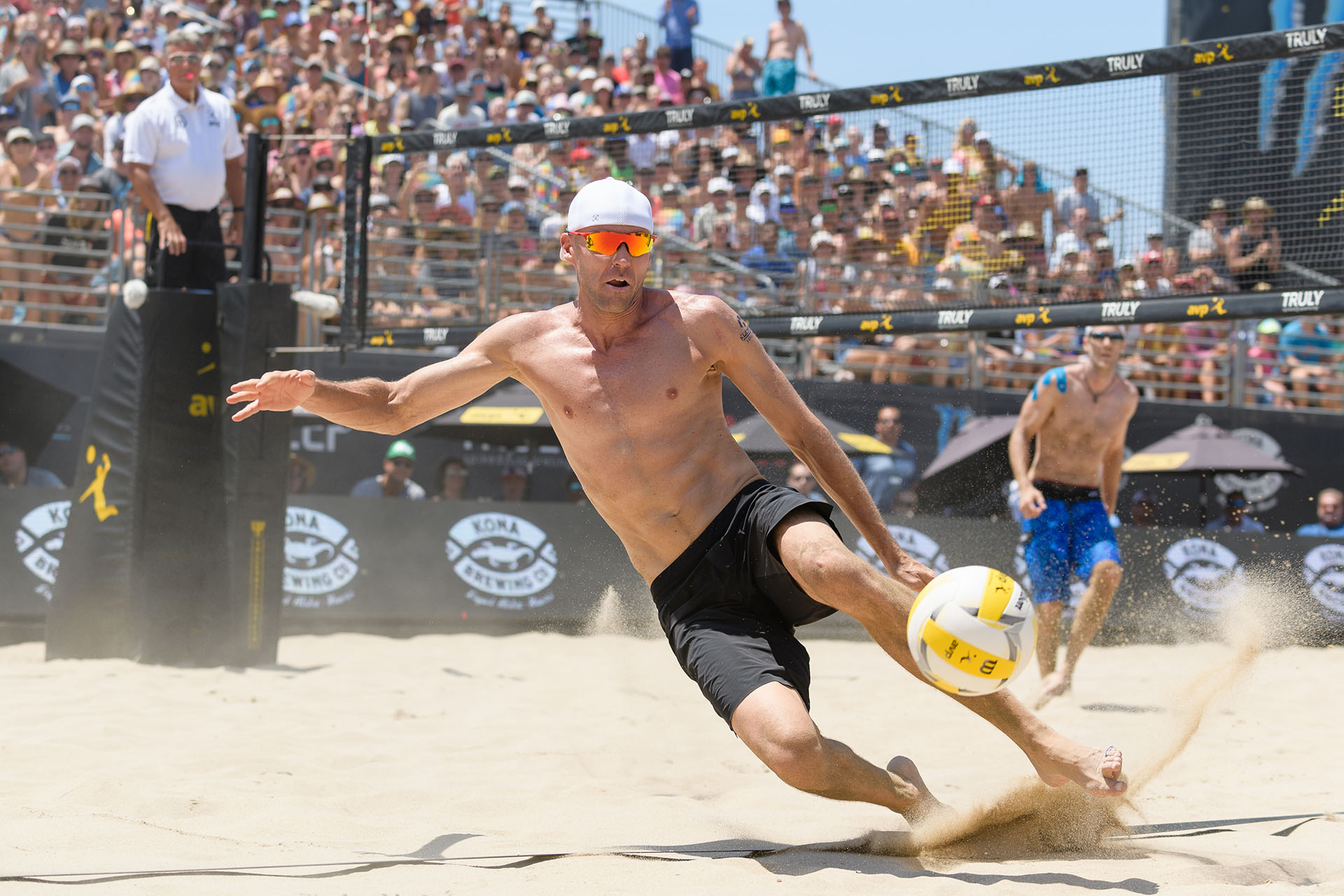
Wednesday Aug 22, 2018
Jake Gibb isn't finished playing just yet
Wednesday Aug 22, 2018
Wednesday Aug 22, 2018
There are exactly two indicators in Jake Gibb’s house that there is a professional volleyball living there.
One is a panorama of the 1976 Manhattan Beach Open, the year Gibb was born. The other is a panorama of the 2005 Manhattan Beach Open, the first of three occasions in which Gibb would win and cement his name onto the famed Manhattan Pier.
“It’s just kind of cool to see what it was when I was born, and you see the crowd just lined up like 30 deep watching, I think it was [Steve] Obradovich and I forget who he was playing with,” Gibb said on SANDCAST: Beach Volleyball with Tri Bourne and Travis Mewhirter. “Then I have my first win, we played actually Nick and Phil, and I played with Stein [Metzger], and it’s a picture that Stein gave me after.”
After that?
Nothing. Nothing from the guy who has been to three Olympics and once, in 2012, finished ranked No. 1 in the world alongside Sean Rosenthal.
“Those,” he said of the Manhattan panoramas, “are the only volleyball pictures I have.”
It really shouldn’t be all too surprising coming from Gibb, who has for years been one of beach volleyball’s most humble ambassadors. It’s not uncommon that his fellow AVP veterans liken him to Tim Duncan, the soon-to-be Hall-of-Famer after a brilliant career with the San Antonio Spurs. It’s easy to see the comparison, for the most notable characteristic the two share – aside from being excruciatingly modest, rarely succumb to any theatrics, unanimously respected by their peers – is this: They just get the job done.
Since the AVP began hosting full seasons again in Donald Sun’s second year of ownership, in 2013, Gibb has won 16 AVP tournaments and competed in five more finals. He has won in Salt Lake City and Cincinnati, in Shanghai and New York, St. Pete’s and Atlantic City. He has won in the torrential rain, as he did in New Orleans of 2015, and stifling heat (Manhattan Beach, 2016).
And, age be damned, at 42 years young, he’s doing it as well as he ever has. In four events this season, his second with Taylor Crabb, Gibb has made at least the semifinals in all four and thrice competed in the finals, beating Dalhausser and Nick Lucena in Seattle.
“I feel like age really isn’t in the equation for me,” he said. “It’s how I’m playing and how I feel and my desire to play and I love playing and I feel like I’m playing well and I feel like I can keep increasing my knowledge of this sport so I want to keep doing it.”
At the moment, it seems he’ll be doing it for another several years longer. Throughout the year, he and Crabb have only improved, finishing their last three FIVB events in the top 10. They claimed a fourth in a major in Gstaad, losing a thriller against current world leaders Anders Mol and Christian Sorum that would have pushed them into the finals.
Two weeks later, at a major in Vienna, they came out of the qualifier to take fifth.
Two weeks after that?
Manhattan Beach, Gibb’s favorite stop. Again, he was in the finals, and had it not been for a swing that went two inches too long at the score freeze in the second set, he’d have had his fourth plaque on the Manhattan Beach Pier with his fourth partner.
“It’s raw right now is where it is,” he said. “I’m going to need some time to let it sit. Like anything, you need time to learn from it, because right now I’m not in that space. Right now, it’s a car ride home by myself with a lot of F bombs and grabbing the wheel.”
There’s not much time for reflection. Two days after Manhattan, Gibb began coaching duties for his son’s soccer team. Then a NORCECA qualifier on the day after that, one that begins the Olympic qualification process. Then it’s onto Chicago, the Netherlands, Hawaii, Vegas, maybe China, he isn’t sure yet.
What he is sure of is this: He wants to go to Tokyo.
And he isn’t ready to retire just yet.
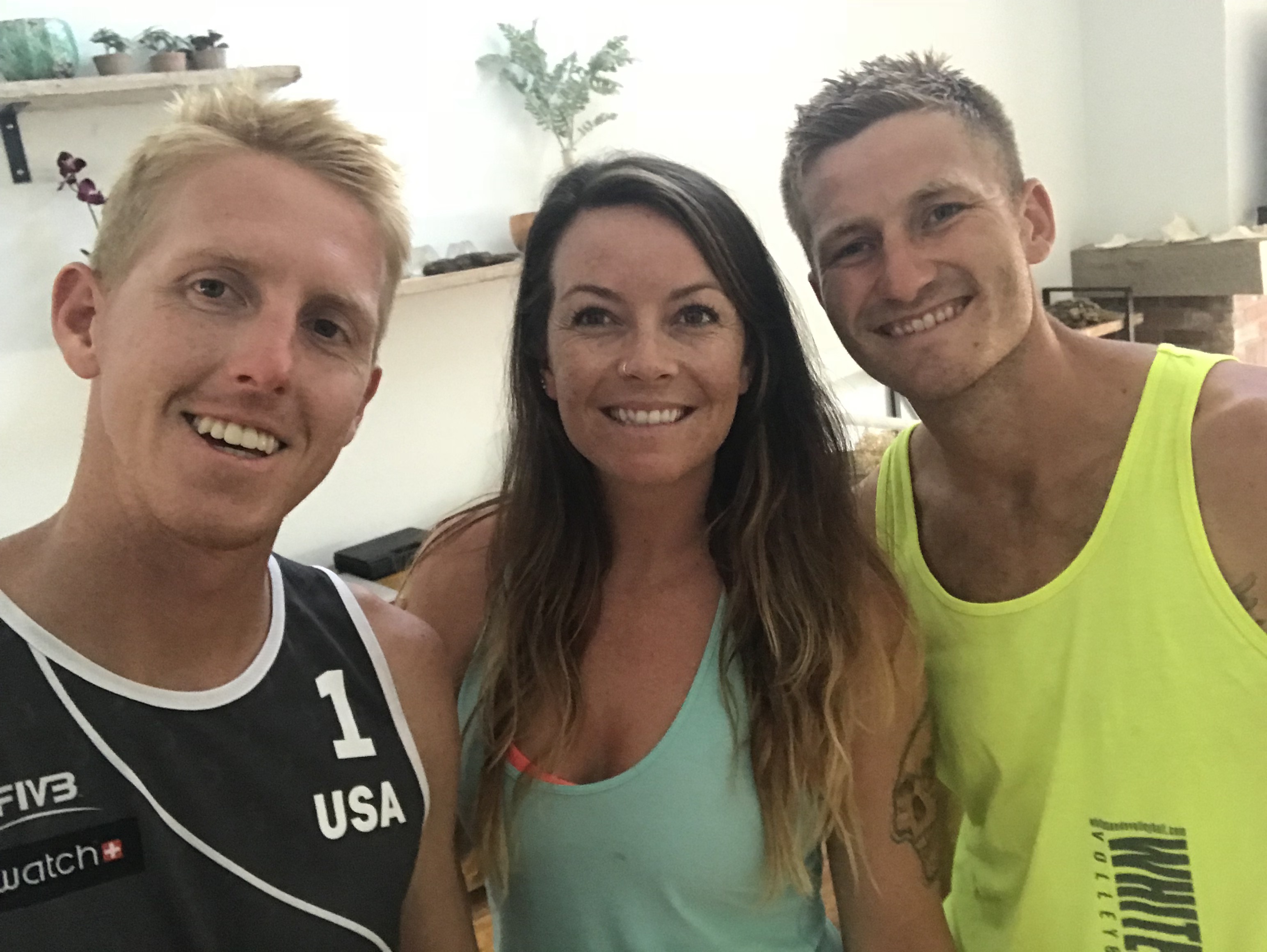
Wednesday Aug 08, 2018
Caitlin Ledoux: Just doux you
Wednesday Aug 08, 2018
Wednesday Aug 08, 2018
It’s a wonder how Caitlin Ledoux did it, given that she operates with the same 24 hours a day, the same seven days a week, as the rest of us.
There she was, working full-time at Lululemon. There she was, coaching two or three club teams and a high school team.
There she was, playing full-time professional beach volleyball, making three quarterfinals and her first career Sunday in Hermosa Beach, capping the year as the AVP’s Most Improved player.
“I worked a lot,” she said on SANDCAST: Beach Volleyball with Tri Bourne and Travis Mewhirter. “Literally seven days a week coaching for four hours a day. That’s what I mean. I was overworked, I was exhausted, my body was struggling to keep up with what I was doing mentally, physically, everything. I just needed to hit that reset button.”
On the court, 2017 had been her most successful year. Off it, it had been both mentally and physically debilitating, something that didn’t go unnoticed by her partner for the final three tournaments, Maria Clara Salgado.
“She knew I was struggling here with my nutrition and my workouts and my working, I had been working a ton. It was too much. She said ‘Come down to Brazil, let’s see what works for you, because what you’ve been doing isn’t really working. Let’s put the reset button on and see if it works.’”
And so, for three months of the “off-season,” Ledoux went to Brazil, getting reps six days a week from four different coaches. She switched her weight routine, swapping out Olympic lifting for more functional movements. She overhauled her nutrition.
“It was the first time I’ve ever felt like a professional athlete,” said Ledoux, who has been playing professionally since she first qualified on the AVP in 2012. “That was career changing. It was amazing.”
Indeed, it seems it has been career-changing. This year, Ledoux has arguably the best case to again take home the AVP’s Most Improved Player, making the quarterfinals in New York with Salgado before getting the call of a lifetime, from perhaps the most dominant female player in the game today: April Ross.
"It was pretty funny because in New York she texted me and said 'Hey I need a practice partner for these days, can you practice with me?' And I had never played or practiced with her so I was stoked to practice with her for two days," Ledoux said. "And I was in the car with my mom and she texted me and I said 'Mom! Guess what just happened?' And she said 'April asked you to play.' And I said 'Yes!' It was awesome."
With Ross playing behind her block, Ledoux made her first final, which may be the match of the year on the AVP thus far, a 21-19, 19-21, 16-18 loss to Emily Day and Betsi Flint. Two weeks later she did it again with Geena Urango, making her third career Sunday and second straight losing once more to Day and Flint in the finals, 17-21, 21-16, 7-15.
Another three weeks after that, in Hermosa, Ledoux was back on a Sunday, falling in three to Ross and Alix Klineman, 14-21, 21-18, 9-15.
“A lot of it is just personal growth about myself and having the right support system around myself the last year and a half,” Ledoux said of her blink-and-you-missed-it rise. “Having that support system and the coaches and helping you figure out what you need to do, I’d say that honestly is the biggest thing.”
What you need to do. It’s a simple concept for Ledoux. Identify what your goal is. Figure out the next step.
Just do.
Olympics, she knew, has been her goal since she was a little girl. How would one get into the Olympics?
Travel. A lot. With no promises of a return anytime soon. So there her and Irene Pollock went, jet-setting across the world, beginning in Russia of 2014. Over the next three years, they went to 16 FIVBs in 10 different countries, qualifying in some, whiffing on others, taking every risk they could, because there were goals to reach and one ladder to get there.
Just go.
“It was hard, but the same time it wasn’t,” Ledoux said. “Irene and I had the same goal and that’s to make the Olympics and we knew that was what we needed to do. We needed to just drown ourselves in all the experience of traveling and losing and having to play these single elimination matches to get that experience. I look back on that year and it was a very draining year but I also learned a lot.
“When you look at the end game: what’s your goal? I had to do it. It’s a no-brainer.”
And sure, it may have been rough for a while. There may have been a learning curve on how to travel internationally, particularly when doing so in, say South Africa.
The investment is beginning to see returns, dividends in the form of a bronze medal (in China with Sarah Sponcil), a silver (in Australia with Jace Pardon) and a gold (in Thailand with Emily Stockman).
“I think there’s probably a more responsible way to do it than the way I did it,” Ledoux said of climbing the ranks of the FIVB. “But I’ve really enjoyed my life the last five years of just doing it and saying yes to a bunch of experiences. One of the cool things about this career is I look back on the last five years and all of the crazy memories I have of going to all of these places and a lot of times I had fun because we lost out super early and we didn’t know how to book flights yet so we’d book our flight home a week or week and a half in these places and we lost on the first day and now we have a week in South Africa and it’s ‘What do we do?’
“I look back on these last five years and I wouldn’t change anything. If you’re looking to just start, I would say set your goal and jump in.”
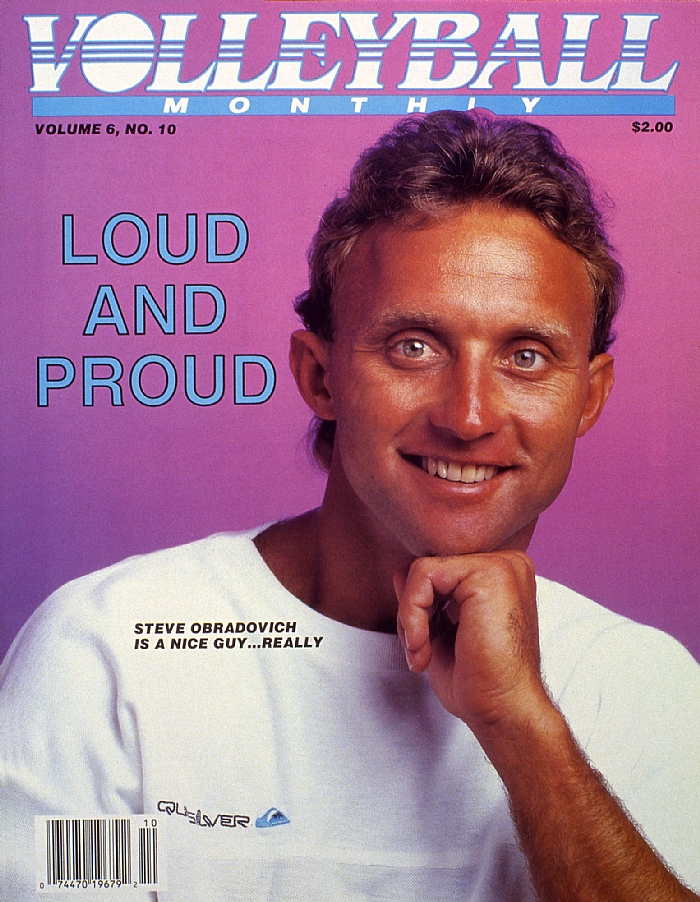
Wednesday Aug 01, 2018
Steve Obradovich: The last true beach volleyball entertainer
Wednesday Aug 01, 2018
Wednesday Aug 01, 2018
Rolling with laughter. That’s likely what Steve Obradovich would be doing at the level of trash talk – what little there is, anyway – on today’s AVP Tour.
Passive aggressive Instagram comments? Staredowns under the net? A few over the top celebrations?
Ha.
That's peanuts. Especially to the old school bona fides, the entertainers like OB.
Take this snippet from an LA Times article from August of 1989:
“You see, Obradovich is the bad boy of the beach. He's "OB," the last of the old-time volleyball rogues. Brash and colorful, an entertainer and, well, not exactly humble. One volleyball publication described him as "the best *!%$&!*% player on the beach (just ask him)."
Anyone who has come upon a beach volleyball event since the mid-1970s would likely remember him. He's the quintessential beach boy with the wavy blond hair and piercing eyes who was doing some or all of the following: (1) shouting at his partner; (2) shouting at the referee; (3) shouting at a loudmouth in the crowd; (4) shouting at himself and (5) using a tremendous leap and lightning quick arm swing to spike the ball at improbable downward angles.
Such an athlete. And such language . Enough to make Zsa Zsa blush.
"I've got a kid on the way, I've played 17 years--I've given half my life to the game--and it's time to move on," said Obradovich as he sat at an outdoor table at Julie's, the restaurant across from USC that his family bought 10 years ago and OB now runs. "I don't want to go out mid-year like Mike Schmidt, hitting .220. I didn't want to go out kneeling in the sand getting the . . . beat out of me."
Memorable? Oh, yes. Obradovich’s name still carries weight, a Hall of Famer with a bigger reputation that is as much about his behavior as it is his talent and record.
“A lot of it was just play acting,” he said on SANDCAST: Beach Volleyball with Tri Bourne and Travis Mewhirter. “That’s what it was. I figured that volleyball just needed somebody like that. I’ve always been a clown, always been loud. I was kicked out of a lot of classes. I wanted to be an entertainer. It was just ‘You guys are so boring. We’re never going to get anybody watching us unless there’s some idiot out there. I don’t think they have any idiots now. They put some tight control on them.”
So talented was he that when Chris Marlowe discovered Obradovich finished his career with 11 open wins, including the 1976 Manhattan Beach Open, he was genuinely confused, telling the LA Times that, had OB put his min dto it, he could have won 30 or 40.
Not that OB disagreed. The two-sport athlete at USC was a known critic of everyone else, but he was hard on himself, too, the first to admit that “I didn’t practice.”
Which isn’t to say he didn’t improve alarmingly, staggeringly fast. The first time he played beach volleyball he was 16. By the time he was 21, his name was on the Manhattan Beach Pier.
But he knew the beach, financially, was never a career option, not in his time period, at least. He had to work full-time, selling liquor, driving from Manhattan Beach to Huntington, working at “grubby bars that were open until six in the morning.” Then he worked at his parents’ restaurant, Julie’s, of which he was a part-owner.
“The question of why I kept playing?” he said. “Well, I was good at it, and I liked playing. I just couldn’t – I had to work. I always had to have a job. I wasn’t the type of guy to go lay around, and I didn’t want to be a waiter. I wanted to do something legit.”
He did. He moved to Laguna Beach, got into real estate. Had a family to provide for, you know? It wasn’t the illustrious year of some of his peers like, say, Sinjin Smith and Karch Kiraly or Mike Dodd or Randy Stoklos.
But it was equally as memorable.
“I got more out of it winning 11 tournaments than guys who won 40 tournaments. Everyone wants to talk to me because I was the John McEnroe, I was the color. Nobody wants to talk to a boring guy. People still come up and talk to me…they remember me, because you’re loud.”